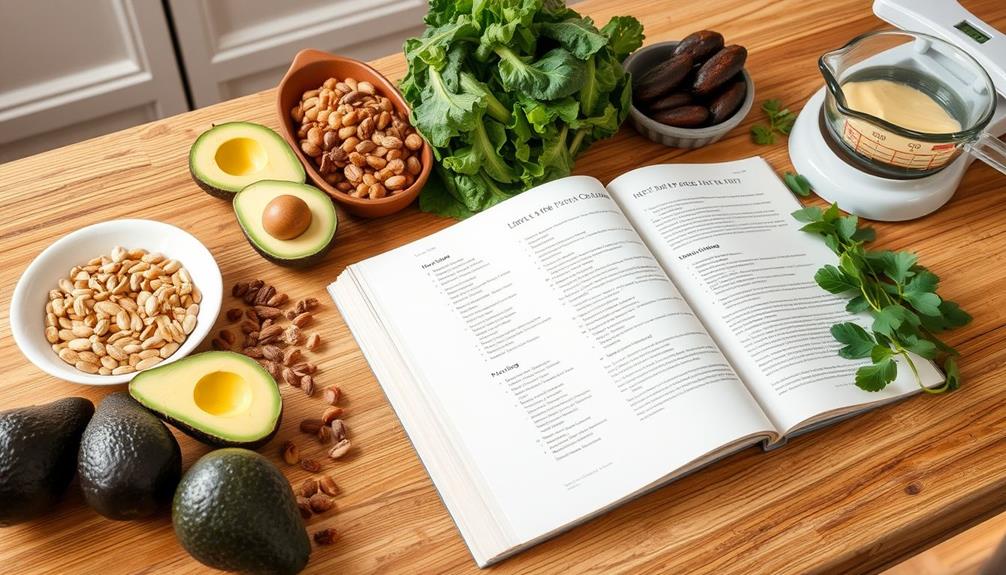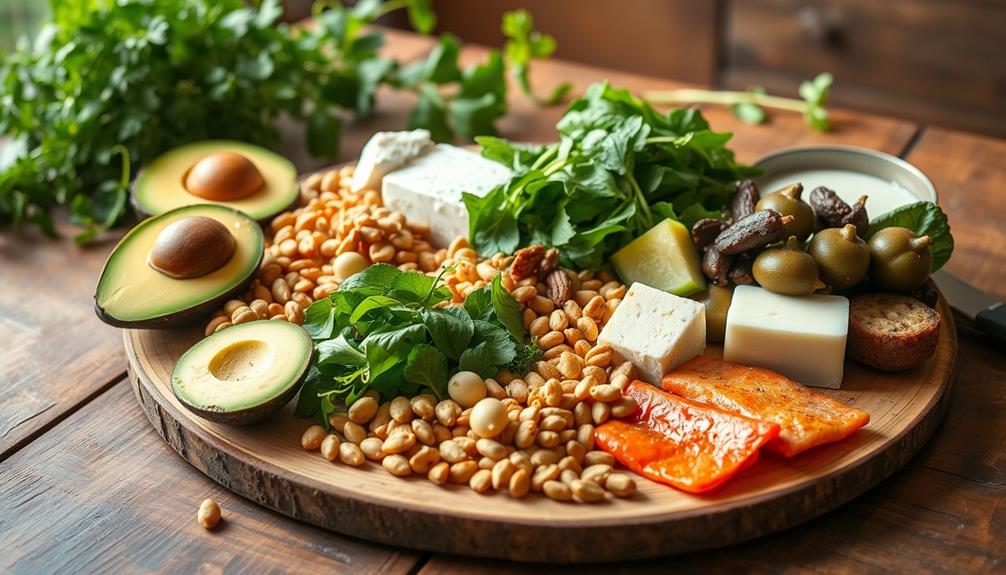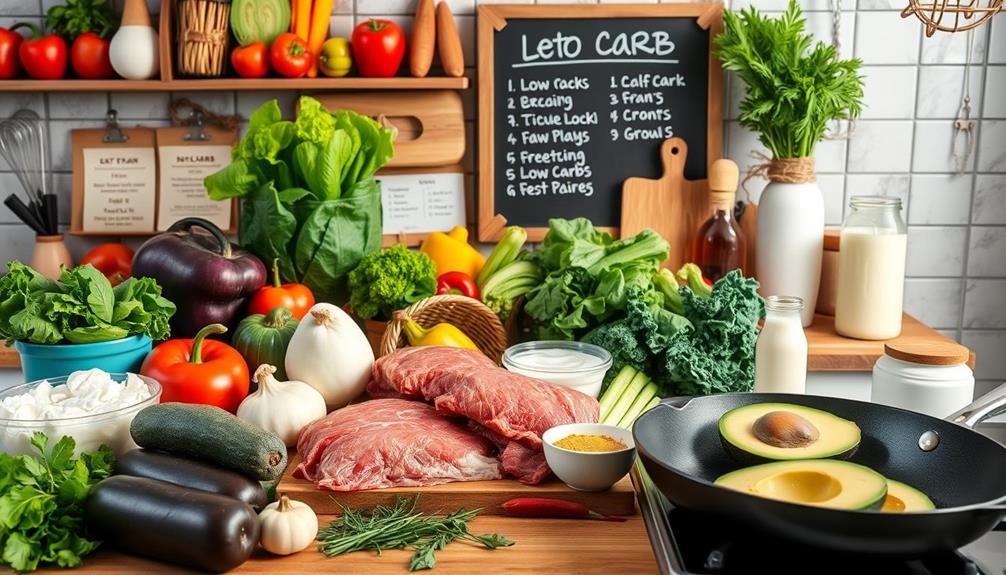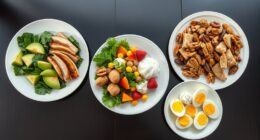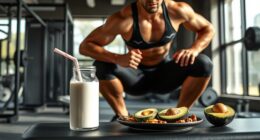To start a keto diet at home, focus on meal planning and selecting the right foods. Aim for low carb intake, under 50g per day, while consuming high-fat foods like avocados, nuts, and fatty meats. Include low-carb veggies and full-fat dairy. Gradually reduce your carbs over a week to ease into ketosis, staying hydrated and boosting your electrolytes with broth or supplements. Meal prep is essential, so batch cook keto-friendly dishes and use containers to manage snacks. By following these steps, you'll set yourself up for success and discover more tips to enhance your keto journey. When starting a keto diet at home, it’s important to familiarize yourself with the keto diet basics. This includes understanding the process of ketosis, where the body switches from using glucose as its main source of energy to using fat. Incorporating healthy fats, such as olive oil and coconut oil, into your meals can help support this process. Additionally, being mindful of your protein intake and choosing high-quality, grass-fed meats and wild-caught fish can also contribute to the success of your keto journey. Starting a ketogenic diet at home also involves being mindful of hidden carbs in condiments and sauces, as well as avoiding processed and sugary foods. It’s important to listen to your body and make adjustments as needed, as everyone’s experience with the keto diet can vary. Taking the time to educate yourself on the potential side effects and how to manage them, such as the keto flu, will also help you stay on track and feel confident in your journey towards a healthier lifestyle. Remember, starting a ketogenic diet is a significant change, so be patient with yourself and celebrate your progress along the way.
Key Takeaways
- Understand the keto diet's macronutrient ratio: 70% fat, 20% protein, and 10% carbohydrates to achieve ketosis effectively.
- Plan meals around high-fat foods, low-carb vegetables, and full-fat dairy while avoiding grains and sugary foods.
- Gradually reduce carbohydrate intake over a week to ease into ketosis and minimize keto flu symptoms.
- Stay hydrated and maintain electrolyte balance by consuming foods rich in sodium, potassium, and magnesium.
- Track your food intake and progress using tools like ketone testing strips to ensure you are in ketosis.
Understanding the Keto Diet
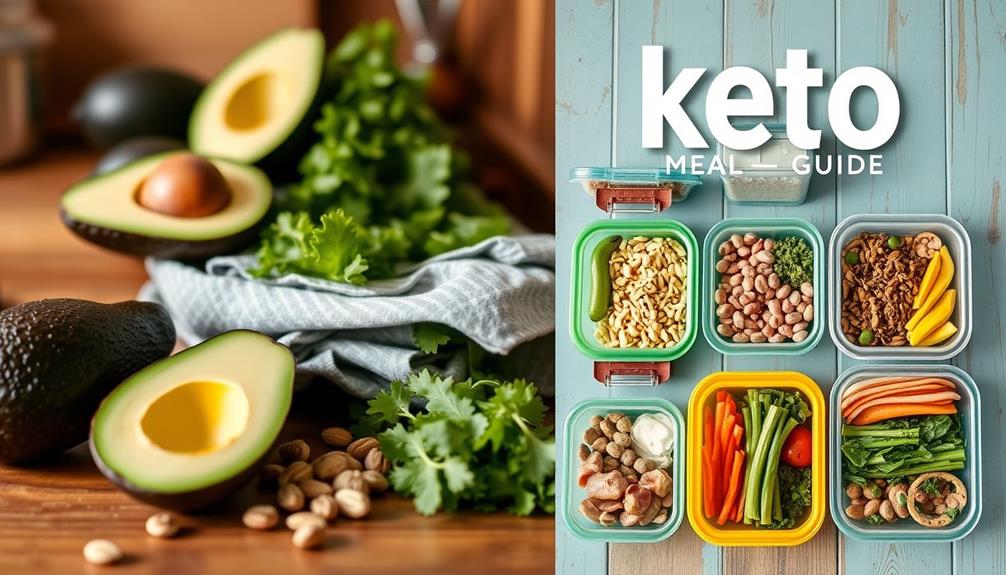
The ketogenic diet is a low-carb, high-fat eating plan that can transform the way your body uses energy. By drastically reducing your carbohydrate intake to less than 50 grams per day, you'll increase your fat consumption to around 70%-80% of your total daily calories. This shift prompts your body to enter a state known as ketosis, where it starts burning fat for energy instead of carbohydrates.
In addition to weight loss, many people find that incorporating nutrient-dense foods can enhance their overall health, similar to the benefits of high antioxidants in celery juice.
In ketosis, your liver produces ketones, which serve as an alternative energy source for your brain. This metabolic shift leads to significant reductions in blood sugar and insulin levels, creating a more stable energy supply throughout the day.
The typical macronutrient ratio for the ketogenic diet is about 70% fat, 20% protein, and only 10% carbohydrates, which sets it apart from other low carb diets.
While many people find that the keto diet helps with weight loss and blood sugar control, it's important to be aware of potential risks. During the initial adaptation phase, you might experience flu-like symptoms often referred to as the "keto flu."
To navigate this, careful meal planning and monitoring are vital for success on the ketogenic diet.
Benefits of the Keto Diet
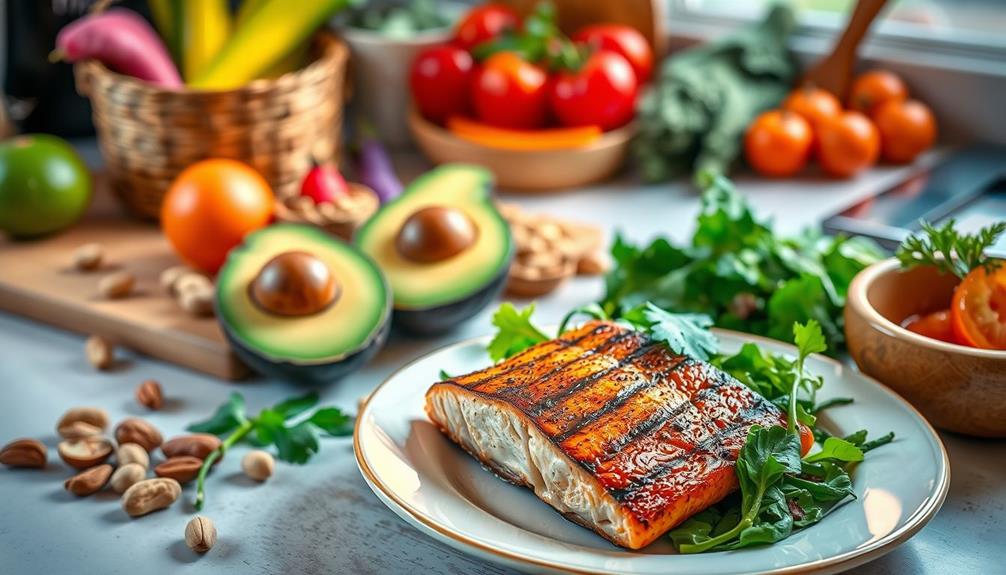
Many people choose the keto diet not just for weight loss, but for its numerous health benefits. One of the most notable advantages is the significant initial weight loss you may experience, often surpassing that of balanced diets in the first 3-6 months. This is due to your body shifting to burning fat for fuel.
Additionally, research shows that about 60% of individuals with type 2 diabetes can reverse their condition through improved blood sugar control while following this diet. This dietary approach can also support overall health, similar to how natural remedies can complement conventional treatments.
You might also notice enhanced mental clarity and energy levels since ketones serve as an efficient brain fuel, potentially improving your cognitive function. For those dealing with epilepsy, especially drug-resistant forms, the keto diet can lead to a substantial reduction in seizure frequency, offering a non-pharmaceutical management option.
Moreover, the diet can positively impact your cholesterol levels. Studies indicate reductions in triglycerides and increases in HDL (good) cholesterol, contributing to better overall cardiovascular health.
Foods to Include and Avoid
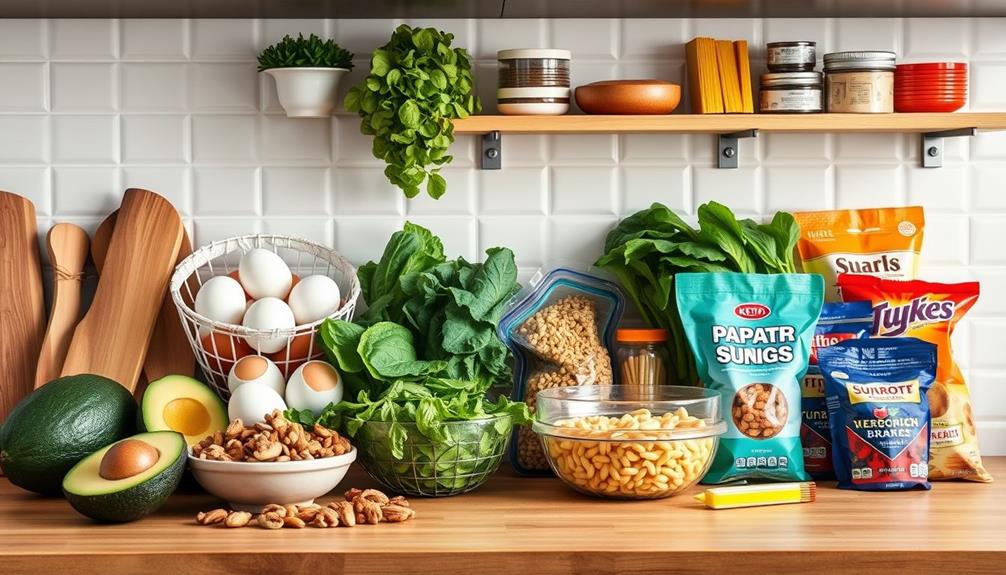
To successfully navigate the keto diet, you'll want to prioritize certain foods while steering clear of others. Focus on high-fat, keto-friendly foods that make up about 70-80% of your daily caloric intake. Think avocados, nuts, seeds, olive oil, and fatty cuts of meat. These healthy fats will keep you satisfied and energized.
Incorporating essential oils for overall wellness can also support your dietary journey; for instance, essential oils for toothache relief can ease discomfort that might arise during your dietary shift.
When it comes to carbs, limit your intake to 20-30 grams per day. Avoid grains, sugary foods, and most fruits—stick with berries in moderation. Steer clear of starchy vegetables like potatoes and corn, as they can quickly push you over your carb limit.
Instead, fill your plate with low-carb vegetables such as spinach, kale, broccoli, and cauliflower for essential nutrients without the excess carbs.
Don't forget about dairy! Choose full-fat options like cheese, butter, and heavy cream, which provide healthy fats without added sugars found in low-fat versions.
Meal Planning for Success
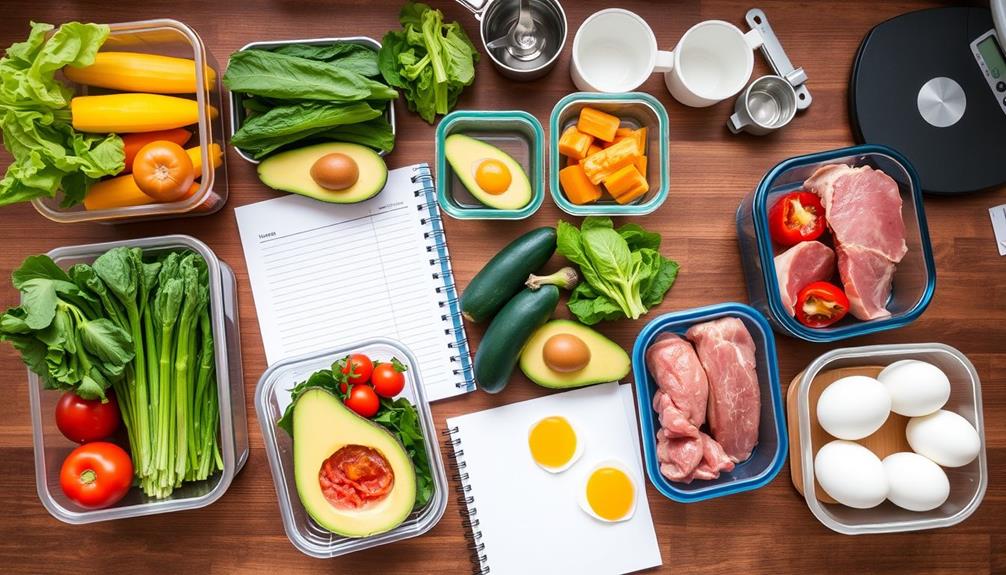
To succeed on your keto journey, it's vital to create a solid meal plan that highlights essential high-fat foods. Incorporating a balanced diet rich in low-carb, high-fat options can greatly enhance your results.
You'll want to focus on a weekly meal prep routine to keep your kitchen stocked with keto-friendly ingredients and avoid last-minute temptations. By planning ahead, you'll make it easier to stick to your goals and enjoy a variety of delicious meals while also considering effective strategies for weight loss.
Essential Food List
When starting on a keto diet, having a well-curated essential food list is crucial for your success. Focus on high-fat foods to meet your macronutrient goals, aiming for approximately 70% fat, 20% protein, and only 10% carbohydrates. Include avocados, nuts, seeds, oils, fatty fish, and meats in your shopping cart.
These foods will help you stay on track with your high-fat diet, while understanding the importance of various brewing methods can also enhance your coffee experience during this dietary shift.
Incorporate low-carb vegetables like leafy greens, broccoli, cauliflower, and bell peppers into your meals. These veggies provide essential nutrients while keeping your carbohydrate intake below 20-30 grams per day.
Remember to avoid starchy foods such as bread, pasta, rice, and sugary items, as they can hinder ketosis.
Utilize healthy fats like olive oil, coconut oil, and butter in your cooking. These fats not only enhance flavors but also guarantee you maintain adequate fat consumption.
Planning meals in advance can be a game-changer, so consider batch cooking keto-friendly recipes. This way, you'll have easy access to compliant foods and reduce the temptation to stray from your diet.
Sticking to this essential food list will set you up for success on your keto journey!
Weekly Meal Prep
How can you set yourself up for success on the keto diet? Start with effective weekly meal prep. Planning your meals around the keto macronutrient ratio—approximately 70% fat, 25% protein, and 5% carbohydrates—ensures you stay within the limit of 20-30 grams of carbs per day for ideal ketosis. Focus on batch cooking low-carb meals like casseroles and grilled proteins, which you can portion and store for the week.
Here's a simple meal prep guide:
| Meal Type | Example Dishes |
|---|---|
| Main Meals | Zucchini lasagna, chicken soup |
| Snacks | Cheese, nuts, hard-boiled eggs |
| Vegetables | Spinach salad, roasted cauliflower |
Incorporate a variety of keto-friendly vegetables to meet your nutrient needs while keeping carbs low. Aim for 2-3 servings of non-starchy veggies daily. Use meal prep containers to organize snacks, helping you manage hunger between meals. Finally, leverage online keto recipes and meal planning apps to discover new ideas and track your macronutrient intake, ensuring your weekly meal prep is both enjoyable and successful.
Managing Keto Flu Symptoms

Experiencing keto flu symptoms can be uncomfortable, but there are effective strategies to manage them.
First, focus on hydration by drinking 6-8 glasses of water daily. Dehydration is common during the initial phase of the keto diet, so keeping your fluid intake high is essential.
Additionally, understanding the importance of proper nutrition can help in managing these symptoms effectively, as seen in discussions about financial considerations for elderly care.
Next, elevate your electrolyte levels. Incorporate broth or consider electrolyte supplements to boost sodium, potassium, and magnesium, as these minerals can greatly reduce symptoms like fatigue and headaches.
Instead of cutting carbs abruptly, gradually decrease your intake over a week. This approach can help ease your shift into ketosis and lessen the severity of keto flu symptoms.
Additionally, make sure you're getting enough nutrition from non-starchy vegetables and healthy fats. These foods not only help you meet your dietary needs but also support your overall well-being during this adaptation phase.
Importance of Electrolytes
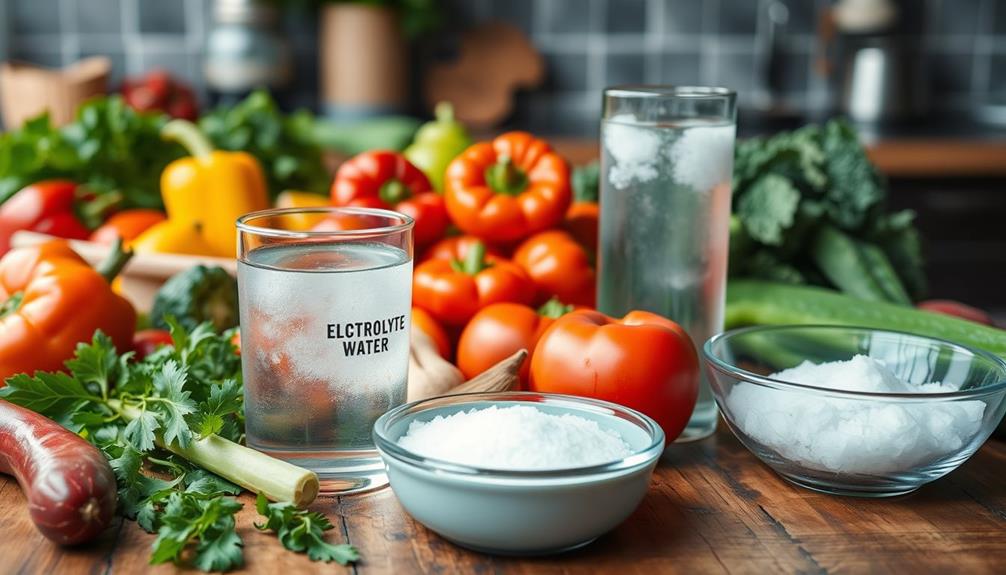
As you start your keto journey, keeping an eye on your electrolytes is essential to avoid symptoms like fatigue and muscle cramps.
Understanding the importance of a balanced budget for your grocery shopping can help you allocate funds for quality food sources of sodium, potassium, and magnesium.
You'll want to know the best sources for sodium, potassium, and magnesium, as well as effective hydration strategies to maintain balance.
Staying proactive about your electrolyte intake can help you feel better and stay on track.
Electrolyte Imbalance Symptoms
Electrolyte imbalances can sneak up on you during the early stages of a keto diet, often manifesting as fatigue, muscle cramps, dizziness, and headaches—collectively known as "keto flu."
Individuals with underlying conditions, such as Borderline Personality Disorder (BPD), may experience heightened emotional instability during this period, making it even more important to monitor electrolyte levels.
These symptoms highlight the essential role electrolytes play in your body's functions, such as regulating nerve signaling and muscle contractions. As you cut back on carbohydrates, your kidneys excrete more sodium and water, potentially leading to electrolyte deficiency.
To keep electrolyte imbalances at bay, watch for these signs:
- Irregular Heartbeats: A fluctuation in your heart rhythm can indicate low potassium or magnesium levels.
- Muscle Weakness: This can result from deficiencies in sodium or potassium, affecting your physical performance.
- Confusion: Feeling foggy or disoriented? This may signal an electrolyte deficiency that needs addressing.
It's vital to prioritize your electrolyte intake during the ketogenic diet.
Make sure to stay hydrated and consider incorporating electrolyte-rich foods into your meals. By doing so, you can help mitigate these uncomfortable symptoms and maintain peak bodily functions throughout your keto journey.
Sources of Electrolytes
To guarantee you're getting enough electrolytes, focus on incorporating foods rich in these essential minerals. For potassium, avocados are an excellent choice; they're not only delicious but also packed with this crucial nutrient.
Additionally, keeping your diet diverse with various healthy options can also enhance your overall nutrient intake, as seen in hamster care diets. Leafy greens are great sources of magnesium, which supports muscle function, while bone broth is an effective way to boost your sodium intake, providing both sodium and trace minerals.
Don't forget to add salt to your meals or consider using electrolyte supplements. Many people on a low-carb diet inadvertently consume less sodium than needed.
Hydration Strategies
Hydration is key to your success on the keto diet, especially when it comes to maintaining a proper balance of electrolytes. As you reduce carbohydrate intake, your body tends to excrete more water and electrolytes, which can lead to dehydration.
This is similar to how inadequate maintenance can affect systems like heat pumps, leading to decreased efficiency. To combat this, focus on the following hydration strategies:
1. Increase Water Intake: Aim to drink at least 6-8 glasses of water daily. If you're exercising or it's hot outside, boost your water intake even more to support your hydration levels.
2. Replenish Electrolytes: Make sure you're getting enough sodium, potassium, and magnesium. Adding broth to your meals or using a pinch of salt can help. Include potassium-rich foods like avocados and leafy greens in your diet.
Additionally, consider incorporating energy-saving features that can help you manage your hydration budget effectively.
3. Monitor Symptoms: Keep an eye out for signs of dehydration, such as dizziness or persistent cravings. If you notice these, it's a cue to increase your fluid and electrolyte intake.
Cooking Skills for Keto
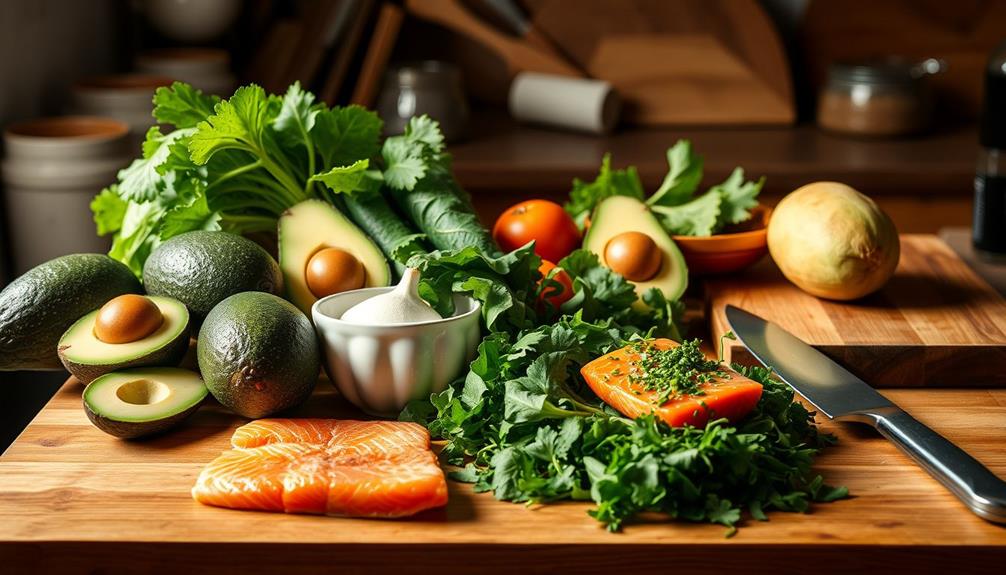
Mastering cooking skills is crucial for anyone starting a keto diet, as it allows you to create delicious, high-fat meals while avoiding hidden carbs. Begin by familiarizing yourself with keto-friendly ingredients. Swap out high-carb foods for low-carb substitutes, like using zucchini noodles instead of pasta or almond flour instead of wheat flour.
Next, master basic cooking techniques such as sautéing, roasting, and grilling. These skills will help you prepare flavorful meals using meats, fish, and low-carb vegetables.
Invest in essential kitchen tools, like a food scale for precise portioning, a spiralizer for making vegetable noodles, and a slow cooker for easy meal prep.
Don't forget to experiment with healthy fat sources! Incorporate oils like olive oil and avocado oil, along with high-fat dairy products like cheese and heavy cream, to enrich your meals.
Utilizing meal planning strategies is crucial for ensuring you have a balanced selection of keto meals throughout the week. Focus on nutrient-dense ingredients and steer clear of processed foods, which often hide unwanted carbs.
With these skills, you're well on your way to enjoying a successful keto journey!
Monitoring Your Progress
Monitoring your progress on a keto diet is essential for staying on track and achieving your health goals. To effectively gauge your success, you should focus on a few key areas:
- Track daily food intake: Keep a detailed log of your meals and macronutrient ratios. Aim for 20-50 grams of carbohydrates, 60-80% fat, and moderate protein to maintain ketosis.
- Assess body composition: Regularly check your weight and fat percentage, targeting a healthy weight loss rate of 1-2 pounds per week. This will help you understand how your body is responding to the diet.
- Use ketone testing: Employ ketone testing strips or a blood ketone meter to confirm you're in ketosis. A ketone level between 0.5-3.0 mmol/L indicates effective fat burning, ensuring that your efforts are paying off.
Additionally, keep a journal to note your physical feelings, energy levels, and any symptoms of the keto flu.
Monitoring these factors will help you identify patterns and make necessary adjustments to optimize your keto journey.
Assessing Long-Term Suitability
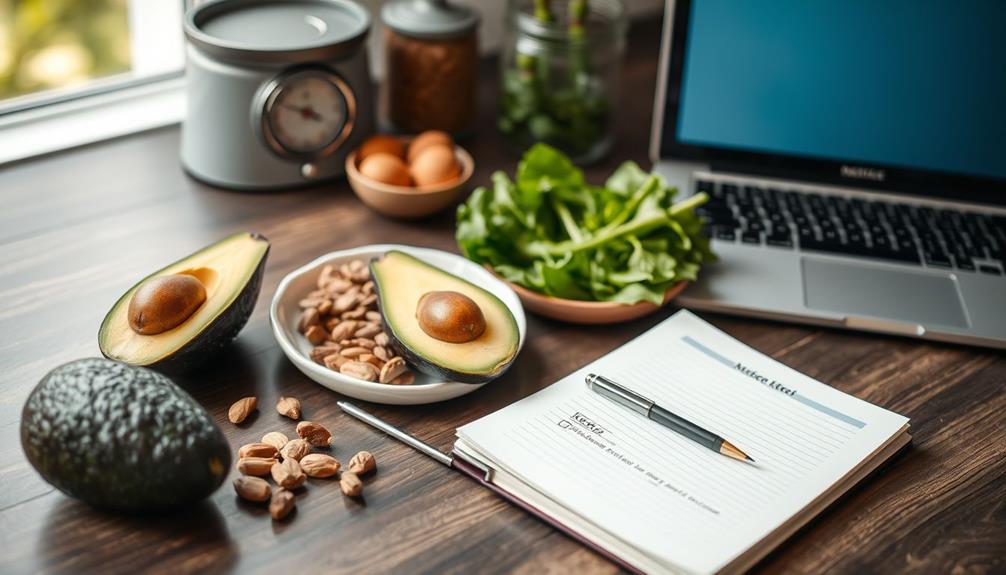
Evaluating the long-term suitability of a keto diet is essential for guaranteeing it aligns with your individual health needs and lifestyle. If you have specific health conditions, like diabetes or heart disease, it's critical to consult a healthcare professional before committing to this diet.
While many experience significant initial weight loss, maintaining strict adherence can be challenging, often leading to weight regain if old habits return.
Long-term sustainability of the keto diet also poses concerns regarding nutrient deficiencies. Due to the limited variety of foods, careful meal planning is necessary to make sure you're getting a balanced intake of vitamins and minerals.
You might explore hybrid diets, like ketotarian or cyclical keto, which offer more flexibility and could enhance your ability to stick with the plan over time.
Regularly monitoring personal health markers, such as cholesterol levels and blood sugar, is essential for evaluating how well the keto diet is working for you. This allows you to make informed dietary adjustments as needed, guaranteeing your approach remains beneficial and sustainable in the long run.
Always listen to your body and prioritize your health above all else.
Frequently Asked Questions
How Do I Start My Keto Diet for the First Time?
To start your keto diet for the first time, cut carbs considerably, prioritize high-fat foods, incorporate low-carb veggies, and prepare for potential symptoms. Use meal planning tools to track your progress and stay on target.
How Do Beginners Get Into Ketosis?
Imagine a ship cutting through fog; that's you entering ketosis. To get there, limit carbs to 20-50 grams daily, focus on healthy fats, and hydrate well. Monitor your progress with ketone strips. You've got this!
What Are the 9 Rules of Keto?
You should follow these nine keto rules: limit carbs, increase healthy fats, moderate protein, focus on whole foods, stay hydrated, manage electrolytes, track your intake, meal prep, and listen to your body's needs for success.
How Does the Keto Diet Work for Beginners?
You're about to uncover a game-changing approach to weight loss. By drastically cutting carbs, your body shifts into ketosis, burning fat for energy. This change might feel tough initially, but the rewards are incredible.
Conclusion
To summarize, starting a keto diet at home can be both rewarding and manageable. With about 30% of adults in the U.S. currently adopting low-carb diets, you're definitely not alone in this journey. By understanding the principles, planning your meals, and staying mindful of your body's needs, you can successfully embrace this lifestyle. Remember, consistency is key, and as you track your progress, you'll find what works best for you in the long run.
